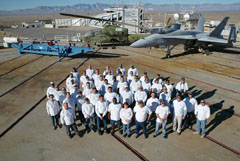
| MANPADS Testing
Means More Survivable Aircraft |
|
|
2/25/2009 - The Naval Air Warfare Center Weapons Division Weapons Survivability Lab (WSL) at China Lake recently developed and verified the capability to accurately and realistically test, evaluate, and document the effects of a Man Portable Air Defense System (MANPADS) impact on aircraft in an effort to make them more survivable. This capability is unique to China Lake, and is known as the Missile Engagement Threat Simulator (METS). “Our ultimate goal is to make sure the pilot completes the mission and returns home safely,” said Ronnie Schiller, METS project manager. MANPADS are shoulder-launched missile systems which are produced by more than 25 countries. MANPADS are relatively inexpensive and widely available to the world, making them a serious threat to U.S. and allied aircraft. METS will play an important role in developing a strategy to severely lessen MANPADS effectiveness by accurately simulating an impact and collecting the necessary data to help predict the vulnerability of aircraft. For the last 20 years, Congress has mandated that new aircraft acquisition programs undergo realistic vulnerability testing before entering low rate initial production. METS was developed at China Lake to help aircraft acquisition programs comply with the Live Fire Test Law by providing a method of effectively evaluating an aircraft’s ability to tolerate MANPADS. “There has been a long chain of challenges throughout this project over the last 15 years,” said Robert Gerber, lead mechanical engineer, “with over 70 individuals contributing with very unique solutions. We have come a long way since the early days of black smoke and mangled missile debris exiting the barrel.” There are three components of METS. First is the portable,
6-inch, high-pressure gas gun. Second is the MANPADS itself. METS uses an actual MANPADS with two minor modifications to the fuze and fins. The foreign fuze is replaced with an exploding bridge wire (EBW) fuze. The fins are replaced with retractable versions that expand once the MANPADS exits the barrel. Third are the screens placed near the target. When the fins contact the charge screens, the current is transferred to the EBW fuze which in turn detonates the warhead. Different MANPADS provide for different fuze timings. By varying the charge screen location, METS has the flexibility to simulate a proximity, contact, or delayed impact detonation. “There’s no other facility to conduct MANPADS testing in a realistic engagement scenario to the fidelity that we can achieve here at China Lake,” Schiller said. The WSL conducted three fully configured METS tests in 2008. An F-14 Tomcat, an AH-1J Sea Cobra, and an F/A-18 Hornet have been tested. The Hornet test was the first test with a live MANPADS detonation on an operating aircraft, using realistic airflow and intercept velocities. METS has several live fire test and evaluation (LFT&E) tests scheduled at China Lake in the coming years with the Joint Cargo Aircraft Program, Joint Aircraft Survivability Program/Joint Live Fire, and the Joint Strike Fighter (JSF) Program. Prior to METS, previous test methods included static warhead testing and free flight testing, which were limited in producing and analyzing realistic conditions, and provided for inadequate data collection. Static warhead testing does not account for the kinetic energy component of damage which can be significant. Free-flight testing limitations include the lack of external airflow, exaggerated impact velocities, and difficulties in targeting. METS addresses all these limitations to create a significantly more realistic test scenario. “To have the capability to repeatedly and reliably throw these weapons at our aircraft, target a certain area, and capture the data is a big deal,” said Chuck Frankenberger, JSF vulnerability LFT&E lead. “We use the data to validate our aircraft vulnerability assessments. MANPADS are one of the threats we assess against. If there is a significant difference between our models and the tests, there could be a design change in the aircraft.” One challenge for the METS team is that it has to deal with constantly evolving threats. “What we hope to build here is an arsenal of all the different types of weapons that could be used against U.S. or allied aircraft,” said Jay Kovar, head of the Vulnerability Branch. “METS is going to be a key tool that provides us the capability to evaluate aircraft against the emerging MANPADS threat.” Source: USN Press Release |
| |
